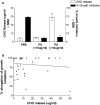Oral and vaginal epithelial cell anti-Candida activity is acid labile and does not require live epithelial cells
- PMID: 15943762
- PMCID: PMC1361270
- DOI: 10.1111/j.1399-302X.2005.00212.x
Oral and vaginal epithelial cell anti-Candida activity is acid labile and does not require live epithelial cells
Abstract
Background: Candida albicans is the causative agent of oral and vaginal candidiasis. Innate host defenses against C. albicans are important against each infection. Among these are oral and vaginal epithelial cells that have anti-Candida activity. The mechanism of action includes a requirement for cell contact with no role for soluble factors, and a putative role for carbohydrates based on the sensitivity of the activity to periodic acid.
Methods: Periodic acid treatment of epithelial cells as well as the property of partial resistance of antifungal activity to fixation was used to further dissect the mechanism of action.
Results: The results herein effectively now challenge a role for carbohydrates alone. Firstly, the putative carbohydrate(s) released into supernatants of periodic acid-treated epithelial cells could not compete with fresh epithelial cells for activity, and equivalent abrogation of activity was observed by periodic acid-treated cells irrespective of the amount of carbohydrate released. Instead, the similar abrogation of activity following treatment with other acids or when cocultured under acidic conditions suggests that the activity is acid-labile. Finally, while activity requires intact epithelial cells, it does not require live cells; activity was minimally affected by fixing epithelial cells prior to coculture where the majority of cells remained impermeable to Trypan blue but were defined as non-viable by positive nuclear staining with propidium iodide.
Conclusion: These results suggest that antifungal activity is dependent on contact by intact, but not necessarily live, epithelial cells through an acid-labile mechanism.
Figures





Similar articles
-
Vaginal and oral epithelial cell anti-Candida activity.Infect Immun. 2002 Dec;70(12):7081-8. doi: 10.1128/IAI.70.12.7081-7088.2002. Infect Immun. 2002. PMID: 12438389 Free PMC article.
-
Annexin-A1 identified as the oral epithelial cell anti-Candida effector moiety.Mol Oral Microbiol. 2010 Aug;25(4):293-304. doi: 10.1111/j.2041-1014.2010.00579.x. Mol Oral Microbiol. 2010. PMID: 20618702 Free PMC article.
-
Potential role for a carbohydrate moiety in anti-Candida activity of human oral epithelial cells.Infect Immun. 2001 Nov;69(11):7091-9. doi: 10.1128/IAI.69.11.7091-7099.2001. Infect Immun. 2001. PMID: 11598085 Free PMC article.
-
Candida-host interactions in HIV disease: relationships in oropharyngeal candidiasis.Adv Dent Res. 2006 Apr 1;19(1):80-4. doi: 10.1177/154407370601900116. Adv Dent Res. 2006. PMID: 16672555 Review.
-
Epithelial cells and innate antifungal defense.J Dent Res. 2010 Jul;89(7):666-75. doi: 10.1177/0022034510368784. Epub 2010 Apr 15. J Dent Res. 2010. PMID: 20395411 Free PMC article. Review.
Cited by
-
Candida-host interactions in HIV disease: implications for oropharyngeal candidiasis.Adv Dent Res. 2011 Apr;23(1):45-9. doi: 10.1177/0022034511399284. Adv Dent Res. 2011. PMID: 21441480 Free PMC article. Review.
-
Cervical mucins carry alpha(1,2)fucosylated glycans that partly protect from experimental vaginal candidiasis.Glycoconj J. 2009 Dec;26(9):1125-34. doi: 10.1007/s10719-009-9234-0. Glycoconj J. 2009. PMID: 19326211 Free PMC article.
-
Candida-induced oral epithelial cell responses.Mycopathologia. 2006 Jul;162(1):25-32. doi: 10.1007/s11046-006-0036-7. Mycopathologia. 2006. PMID: 16830188
-
Cytokines in the host response to Candida vaginitis: Identifying a role for non-classical immune mediators, S100 alarmins.Cytokine. 2012 Apr;58(1):118-28. doi: 10.1016/j.cyto.2011.11.021. Epub 2011 Dec 17. Cytokine. 2012. PMID: 22182685 Free PMC article. Review.
-
Vaginal Heparan Sulfate Linked to Neutrophil Dysfunction in the Acute Inflammatory Response Associated with Experimental Vulvovaginal Candidiasis.mBio. 2017 Mar 14;8(2):e00211-17. doi: 10.1128/mBio.00211-17. mBio. 2017. PMID: 28292981 Free PMC article.
References
-
- Barousse MM, Steele C, Dunlap K, Espinosa T, Boikov D, Sobel JD, Fidel PL., Jr. Growth inhibition of Candida albicans by human vaginal epithelial cells. J Infect Dis. 2001;184:1489–1493. - PubMed
-
- Darzynkiewicz Z, Li X. Measurements of cell death by flow cytometry. In: Cotter TG, Martin SJ, editors. Techniques in apoptosis. A user's guide to cytometry. Portland Press; London: 1996. pp. 71–106.
-
- Dubois M, Gilles KA, Hamilton JK, Rebers PA, Smith F. Colorimetric method for determination of sugars and related substances. Anal Chem. 1956;28:350–356.
-
- Fichorova RN, Rheinwald JG, Anderson DJ. Generation of papillomavirus-immortalized cell lines from normal human ectocervical, endocervical, and vaginal epithelium that maintain expression of tissue-specific differentiation proteins. Biol Reprod. 1997;57:847–855. - PubMed
Publication types
MeSH terms
Substances
Grants and funding
LinkOut - more resources
Full Text Sources

